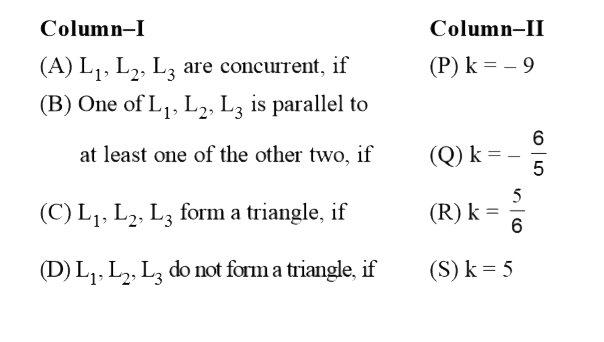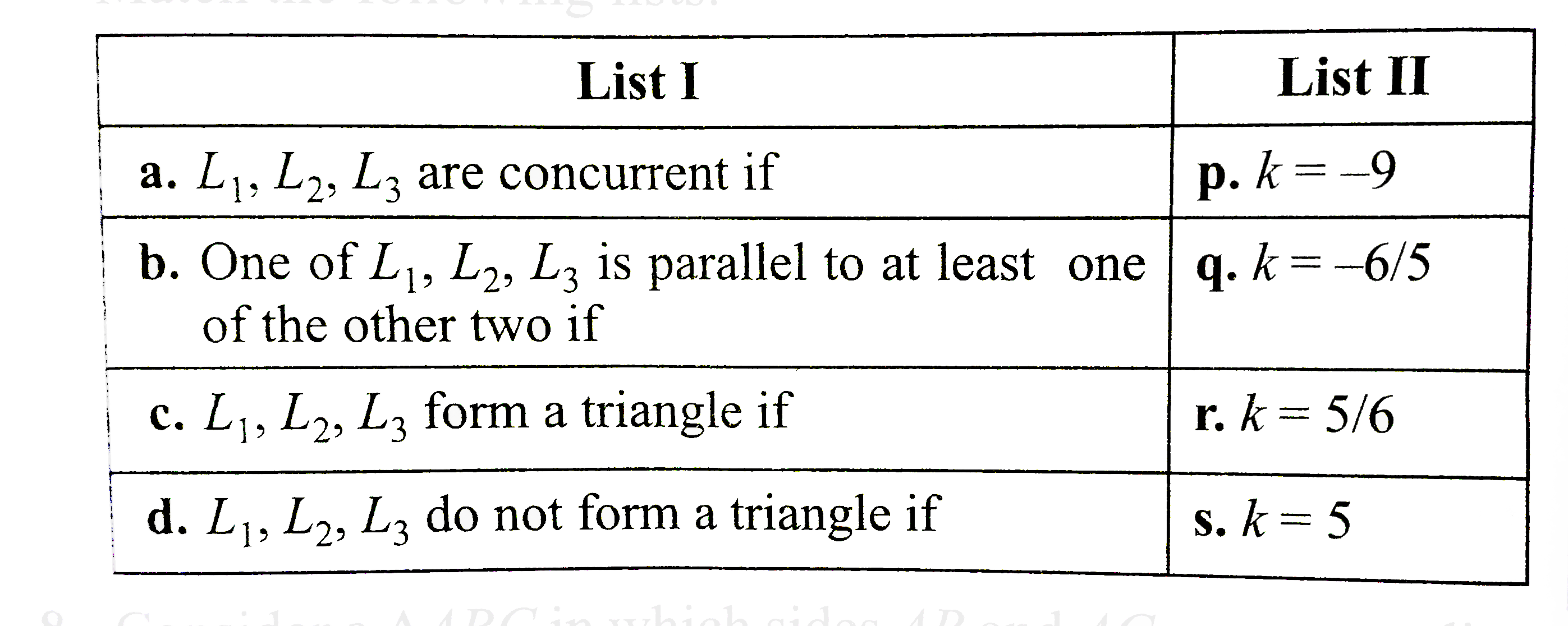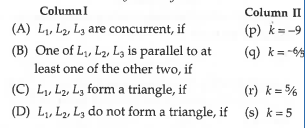Consider the lines given by
L1:x+3y−5=0, L2:3x−ky−1=0 L3:5x+2y−12=0
Column-IColumn-II(A),L1,L2,L3 are concurrent, if(p)k=−9(B) One of L1,L2,L3 is parallel to at least one of the other two, if(q)k=−65(C)L1,L2,L3 from a triangle, if(r)k=56(D)L1,L2,L3 do not from a triangle, if(s)k=5
The correct Answer is:(A→s,B→p,q,C→r,D→p,q,s)
To solve the problem, we need to analyze the three lines given by their equations and determine the conditions under which they are concurrent, parallel, or form a triangle.
Step 1: Identify the equations of the lines
The equations of the lines are:
1. L1:x+3y−5=0
2. L2:3x−ky−1=0
3. L3:5x+2y−12=0
Step 2: Check for concurrency
For the lines to be concurrent, the determinant of the coefficients of x, y, and the constant term must be zero. The determinant can be set up as follows:
∣∣
∣∣13−53−k−152−12∣∣
∣∣=0
Calculating the determinant:
=1∣∣∣−k−12−12∣∣∣−3∣∣∣3−15−12∣∣∣+(−5)∣∣∣3−k52∣∣∣
Calculating each of the 2x2 determinants:
1. ∣∣∣−k−12−12∣∣∣=(−k)(−12)−(−1)(2)=12k+2
2. ∣∣∣3−15−12∣∣∣=(3)(−12)−(−1)(5)=−36+5=−31
3. ∣∣∣3−k52∣∣∣=(3)(2)−(−k)(5)=6+5k
Substituting back into the determinant:
1(12k+2)−3(−31)−5(6+5k)=0
Simplifying:
12k+2+93−30−25k=0
−13k+65=0
k=5
Step 3: Check for parallel lines
For the lines to be parallel, the ratios of the coefficients of x and y must be equal for at least one pair of lines.
1. Comparing L1 and L2:
13=3−k⟹k=−9
2. Comparing L2 and L3:
35=−k2⟹−k=65⟹k=−65
Step 4: Check for triangle formation
The lines will form a triangle if they are neither concurrent nor parallel. This means that k should not be equal to 5, -9, or -6/5.
Summary of Results
- (A) Lines are concurrent if k=5.
- (B) At least one line is parallel to another if k=−9 or k=−65.
- (C) Lines form a triangle if k is any value except 5, −9, or −65.
- (D) Lines do not form a triangle if k=5, −9, or −65.
Final Answers
- (A) k=5
- (B) k=−9 or k=−65
- (C) k≠5,−9,−65
- (D) k=5, −9, or −65
The equations of the lines are:
1. L1:x+3y−5=0
2. L2:3x−ky−1=0
3. L3:5x+2y−12=0
For the lines to be concurrent, the determinant of the coefficients of x, y, and the constant term must be zero. The determinant can be set up as follows:
∣∣13−53−k−152−12∣∣
∣∣=0
−13k+65=0
k=5
For the lines to be parallel, the ratios of the coefficients of x and y must be equal for at least one pair of lines.
13=3−k⟹k=−9
35=−k2⟹−k=65⟹k=−65
The lines will form a triangle if they are neither concurrent nor parallel. This means that k should not be equal to 5, -9, or -6/5.
- (A) Lines are concurrent if k=5.
- (B) At least one line is parallel to another if k=−9 or k=−65.
- (C) Lines form a triangle if k is any value except 5, −9, or −65.
- (D) Lines do not form a triangle if k=5, −9, or −65.
- (A) k=5
- (B) k=−9 or k=−65
- (C) k≠5,−9,−65
- (D) k=5, −9, or −65
Similar Questions
Knowledge Check
The three lines l1=4x−3y+2=0,l2=3x+4y−4=0 and l3=x−7y+6=0
Aform a rt. angled isosceles triangleBform a rt. Angled triangleCare concurrentDNoneConsider the lines L1≡3x−4y+2=0 and L2≡3y−4x−5=0. Now, choose the correct statement(s).
AThe line x+y=0 bisects the acute angle between L1and L2 containing the origin.BThe line x-y+1=0 bisects the obtuse angle between L1 and L2 not containing the origin.CThe line x+y+3=0 bisects the obtuse angle between L1 and L2 containing the origin.DThe line x-y+1=0 bisects the acute angle between L1 and L2 not containing the origin.Consider three planes P1:x−y+z=1
P2:x+y−z=−1
and P3:x−3y+3z=2
Let L1,L2,L3 be the lines of intersection of the planes P2 and P3,P3 and P1,P1 and P2 respectively.
Statement I Atleast two of the lines L1,L2 and L3 are non-parallel.
Statement II The three planes do not have a common point.AStatement I is true, Statement II is also true,
Statement II is the correct explanation of
Statement IBStatement I is true, Statement II is also true,
Statement II is not the correct explanation of
Statement ICStatement I is true, Statement II is falseDStatement I is false, Statement II is true
L1=x+3y−5=0,L2=3x−ky−1=0,L3=5x+2y−12=0 are concurrent if k=
View SolutionConsider the lines given by : L1:x+3y−5=0,L2:3x−ky−1=0,L3:5x+2y−12=0 If a be the value of k for which lines L1,L2,L3 do not form a triangle and c be the value of k for which one of L1,L2,L3 is parallel to at least one of the other lines, then abc=
View SolutionConsider the lines given by
L1=x+3y–5=0
L2=3x–ky–1=0
L3=5x+2y–12=0
Match the statements/Expression in Column-I with the statements/Expressions in Column-II and indicate your answer by darkening the appropriate bubbles in the 4 × 4 matrix given in OMR.

View SolutionFor the lines L1:3x−2y+5=0andL2:kx+by–15=0 L1 is perpendicular to L2 if k=4.
View SolutionIf L1,L2, denote the lines x+2y–2=0,2x+3y+4=0
View Solution

